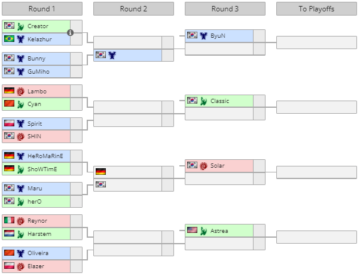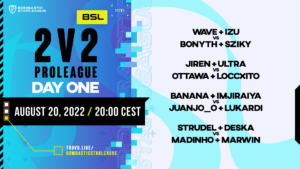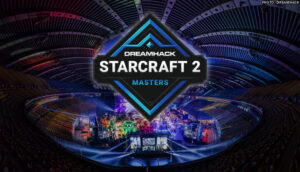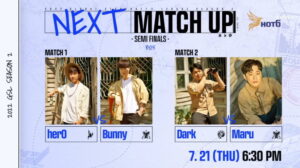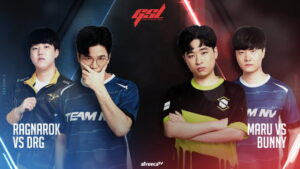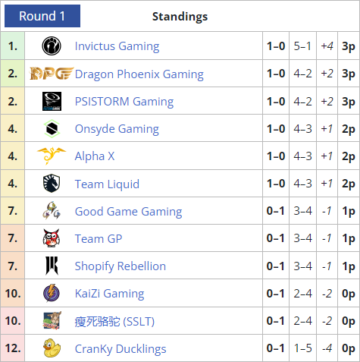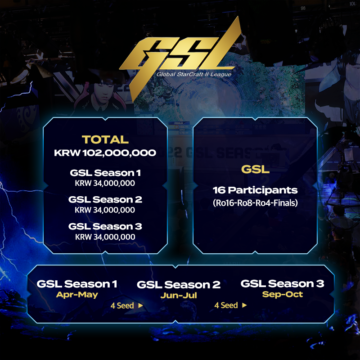The last two Code S semifinalists have been decided, with ![]() herO and
herO and ![]() GuMiho beating out
GuMiho beating out ![]() DongRaeGu and
DongRaeGu and ![]() Cure in Round-of-6 competition. While herO was the first to book his semifinal spot with a 3-2 victory over DRG, the true star of the night was GuMiho who won two consecutive reverse-sweep series to advance. In his post-match interviews, GuMiho considered his reverse-sweep victories to be a good omen—he had survived similar close calls in Code S winning season back in 2017.
Cure in Round-of-6 competition. While herO was the first to book his semifinal spot with a 3-2 victory over DRG, the true star of the night was GuMiho who won two consecutive reverse-sweep series to advance. In his post-match interviews, GuMiho considered his reverse-sweep victories to be a good omen—he had survived similar close calls in Code S winning season back in 2017.
The first series between herO and DRG saw the two players try to outfox each other, bringing a variety of unorthodox builds and cheeses to the table (including the second Blink-DT rush we’ve seen this season). herO’s bag of tricks proved to be just deep enough to give him the victory, as he prevailed with a narrow 3-2 victory.
GuMiho was put on the ropes by both Cure in and DRG in his series, and his situation seemed especially dire as both players found a way to break his favored mech-Terran style. However, GuMiho proved he was more than just a one-trick robot pony, pulling out a variety of different strategies and timings to come back against both opponents.
Code S will continue with the semifinals on Thursday, Oct 06 9:30am GMT (GMT+00:00), with Maru facing herO and GuMiho taking on RagnaroK.
[embedded content]
Match Recaps
#2 Seed Match: herO [3 – 2] DongRaeGu
Game 1 – Inside and Out (DRG win): herO attempted a Twilight-first opener, looking to go into very fast Glaive-Adepts. However, this was hard-countered by DongRaeGu’s Ling-Bane all-in, which killed herO in the opening minutes.
Game 2 – Tropical Sacrifice (herO win): Once again, herO went for a Twilight-first opener, this time going for a Blink-DT rush (similar to the one Prince used to steal a map off Dark in the RO20). DongRaeGu went for another early strike, this time hitting with Speedlings before transitioning into a macro game. The attack breached the Protoss wall and dealt a fair amount of damage, and also let DongRaeGu see the Dark Shrine.
Yet, DRG was still not prepared for the 6 DT’s that blinked into his natural, hacked down his Hatchery, and then blinked out to safety. herO then converted those DT’s into 3 Archons for a follow-up attack, which dealt even more damage and put DRG even further behind. Mid-game Mutalisks failed to turn the tide for DRG, and he GG’d out after a desperation attack.
Game 3 – Cosmic Sapphire (herO win): After two games of trying to confuse DRG with Twilight-first openers, herO finally went for a more ‘herO-style’ opener with Oracles and Blink-Stalkers. herO opted to play a variant that goes for a fast Blink-Stalker all-in, hitting hard at around the 6:45 mark. This attack struck precisely at DRG’s weakest moment where he was defending with Queen-Ling and waiting for Hydras to hatch, forcing another surrender out of DRG.
Game 4 – Moondance (DRG win): herO opened Stargate again, but this time it was for a fast Void Ray. But instead of clearing out the Overlord and taking a fast third base at his backdoor expansion, herO opted to stay on two bases and go for the unusual combination of 2-Stargate Phoenixes and Glaive Adepts.
Fortunately for DRG, he managed to slip a slow Overlord past the Void Ray and get off a timely scout in herO’s main. This allowed him to get enough Queens and Roaches to hold off herO’s attack, and then promptly counter-attack with a Nydus. herO divided DRG’s attention between offense and defense by going for backdoor attacks with Phoenix-Adept, but he ultimately had to GG out against the overpowering Roach-Ravager-Queen army at his doorstep.
Game 5 – Data-C (herO win): herO went for another peculiar Stargate opener, going up to 5 Oracles off of one Stargate. This proved to be quite effective in tying DongRaeGu up and dealing decent damage, setting herO up comfortably on three bases. An Oracle + Chargelot attack hit before DRG was ready, canceling his fourth base and putting Protoss ahead on economy.
herO kept his offensive going with the addition of Archon and Disruptor support, keeping DRG pinned back and on a low expansion count. The arrival of Mutalisks gave DongRaeGu a tiny bit of breathing space, but herO simply added Phoenixes and ran over DRG with his superior economy.
#3 Seed Match: GuMiho [3 – 2] Cure
Game 1 – Waterfall (Cure win): The two Terrans opened up with slightly different Factory-CC openers—Cure got a faster Reactor on his Barracks to pump out Reapers, while GuMiho played a more defensive 1/1/1 style with Cyclones.
Cure committed hard to his early Reaper-Hellion attacks, eventually managing to kill a decent number of SCV’s at the cost of army losses. GuMiho decided he had to deal some damage in return, cutting SCV production and delaying his third CC for a counterattack. However, he couldn’t exploit the window where he had an army advantage, and ended up horribly behind after his counterattack failed. From there on, it was a rudimentary clean-up job for Cure.
Game 2 – Moondance (Cure win): Cure decided to go for a 2-Barracks Reaper strategy from his main, while GuMiho played another Cyclone-based Factory-CC opener. Cure’s good micro let him deal quite a bit of damage with his Reapers, putting himself considerably ahead as the two players headed into the mid-game. However, Cure got a little too hasty in trying to consolidate his lead, and he lost a significant number of troops trying to pierce GuMiho’s 3-base defensive mech. Cure’s losses put the two players on fairly even footing as they set themselves for a classic Bio vs Mech duel.
Cure’s overaggression may have been a mistake when GuMiho was turtling on three bases, but it proved to be the right move later on. Once GuMiho left the safety of his natural and backdoor expansion, he opened himself up to many more angles of attack. Cure exploited the newly vulnerable GuMiho mercilessly, dragging the slow mech army out of the place and attacking the weakest positions. GuMiho crumbled before this hyper-mobile bio army and GG’d out.
Game 3 – Data-C (GuMiho win): GuMiho started by proxying his single Barracks in the middle of the map before transitioning into a 2-Factory, Mag-field upgraded Cyclone strategy. On the other hand, Cure played a more conventional 1/1/1 style, getting un-upgraded Cyclones on defense and going for delayed Cloaked Banshees for harassment. Neither player gained a significant advantage from skirmishing and harassment in the early game, and it seemed like they were headed toward another bio vs mech duel in the mid-game.
However, GuMiho managed to exploit a small window before Cure’s infantry hit critical mass, where his Cyclone-Tank-Viking could still excel in small-scale fights. Not only did he force a lift off on Cure’s third base, but he actually managed to destroy it with the huge burst damage of Mag-field Cyclones. This loss put Cure at a severe economic deficit, and he GG’d out without a fight not too long after.
Game 4 – Inside and Out (GuMiho win): Both players went for 1/1/1 style builds again, with Cure going for fast 1-Medivac/1-Tank while GuMiho went for defensive Cyclones into Banshee. The two squads of early game troops clashed early toward GuMiho’s side of the map, resulting in a fairly even trade that saw both players transition into passive macro play.
This time, the slow build-up actually held without much interruption, and the game turned into a typical Marine-Tank standoff in TvT. Neither player wanted to commit to any extreme actions in the mid-game, and thus the game continued along with both players making preparations for late-game transitions.
However, we didn’t end up seeing the mass Viking-Raven stage, as GuMiho created an unexpected window of opportunity. At around the 15 minute mark, GuMiho managed to draw a large chunk of Cure’s army out of position, leaving a part of Cure’s Tank line without proper support. GuMiho pounced on this hole with his Ravens and Tanks, breaking a hole in Cure’s defensive line and securing a great forward position.
GuMiho used this advantageous position to continue to snowball the game, continuing to push forward and lay siege to Cure’s bases. Eventually, the losses were too much for Cure to handle and he had to GG out.
Game 5 – Cosmic Sapphire (GuMiho win): Cure went for a similar Reaper-Hellion poke from game one, which netted him quite a few SCV kills against GuMihi’s greedy fast-Banshee build with a delayed Cyclone. GuMiho’s Banshee couldn’t inflict much damage in return, and the sheer size of the map forced GuMiho to settle for playing out a macro game from an early disadvantage.
Cure went for a standard bio composition as in the previous games, while GuMiho decided to play a defensive mech style once again. Rather than get too aggressive, Cure decided to play his advantage out slowly this time around, keeping control of the map and teching up freely. Oddly enough, Cure went with a Viking + ranged Liberator composition to supplement his infantry, rather than try to match the enemy’s Tank count directly. However, this ended up being a rather poor move for Cure, as he wasn’t able to deal much damage when he had an air advantage. GuMiho reacted quickly by adding both Thors and Vikings to his army, which quickly wiped away Cure’s advantage in the sky. Without air superiority, Cure’s Infantry-Viking-Liberator was rendered almost completely ineffectual, and he eventually GG’d out against a powerful, high-value composition of Tanks, Vikings, and Thors.
Decider Match: GuMiho [3 – 2] DongRaeGu
Game 1 – Tropical Sacrifice (DRG win): GuMiho played a Cyclone drop opener which turned out to be a starting off point for Battlecruiser-mech. Despite DRG slipping in a slow Overlord and finding out GuMiho’s intent early, he wasn’t able to do much to stop the Terran war machine from coming online. While DRG successfully stopped a mid-game attack of Cyclone-BC-Hellion, it still seemed like he was on a timer to stop GuMiho’s mech from getting completely out of control.
Fortunately for DRG, he was able to hit the breaks on GuMiho in time. He pummeled GuMiho with a series of Roach-Ravager-Corruptor attacks, with GuMiho just barely holding out each time. In the end, GuMiho was never able to fully stabilize, and GG’d out after a long but ultimately doomed defense. GuMiho later expressed his disappointment with this game in his post-match interview, lamenting how he let such an advantageous start slip away from home.
Game 2 – Inside and Out (DRG win): GuMiho went for a Hellbat timing, but found himself hard-countered by DongRaeGu’s Roach opener. After stopping the Hellbats, DRG counter-attacked with Roach-Ravager to deal significant economic damage to GuMiho. While GuMiho did a surprising amount of damage with a desperate Marine-Tank push, the gap was already too large to overcome and he had to GG out.
Game 3 – Data-C (GuMiho win): DRG went for a Pool-Gas to start, but it ended up being a waste as he wasn’t able to do much damage against GuMiho’s Reaper opener. This small early game advantage snowballed quickly for GuMiho, as his follow-up Marine-Medivac drop kept the pressure on DRG and slowed him down. DRG wasn’t ready to defend when GuMiho came knocking with his stim upgrade complete and was forced to surrender the map.
Game 4 – Stargazers (GuMiho win): GuMiho played the map in a fairly straight-forward manner, taking his natural and backdoor expansions while preparing for Marine-Medivac play. His Cloaked-Banshee harass ended up being a surprise difference-maker, however, as DRG struggled to have Queens in the correct position. The Banshees softened DRG up considerably, letting GuMiho continue to pile on the pressure with bio.
DRG managed to stay alive and reach Hive tech, but he couldn’t save up the money for any useful high tech units except a few Vipers. Ultimately, the never-ending Terran parade push overwhelmed his Ling-Bane army and he had to GG once again.
Game 5 – Moondance (GuMiho win): GuMiho played a relatively conventional opener once again, opening Reaper and setting himself up on three bases. However, he gave things a minor twist by making just a single Engineering Bay instead of the usual two, committing to heavy Marine-Medivac pressure in the early/mid-game. This paid off in spades, as he was able to find a gap in DRG’s Queen-Ling defense and land three Medivacs in the Zerg main. These forces tradedly incredibly efficiently against the Zerglings that streamed in single file, giving GuMiho the opportunity to launch a frontal attack. DRG was heavily outmanned on the front line as well, and had no choice but to GG out to the superior Terran force.


